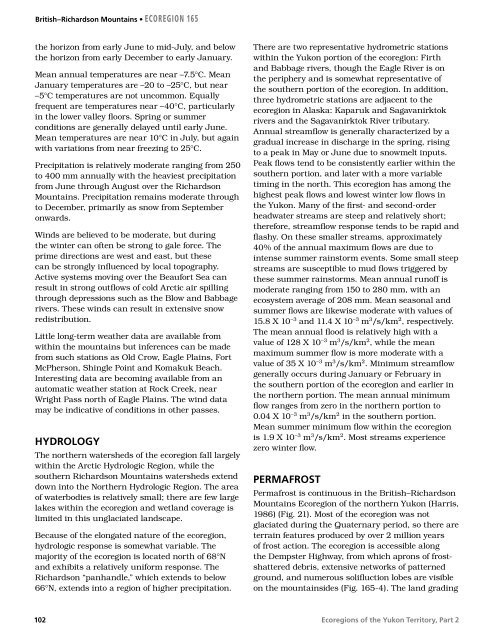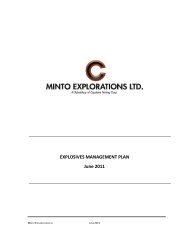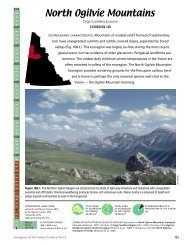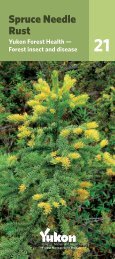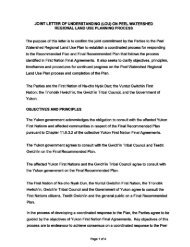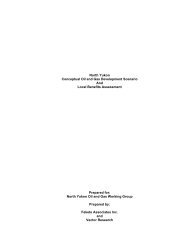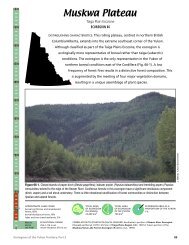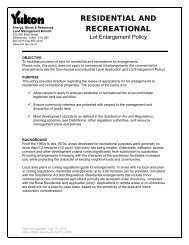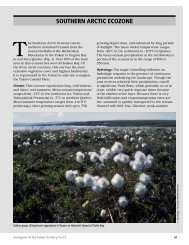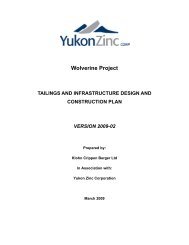British–Richardson Mountains • ECOREGION
British–Richardson Mountains • ECOREGION
British–Richardson Mountains • ECOREGION
Create successful ePaper yourself
Turn your PDF publications into a flip-book with our unique Google optimized e-Paper software.
<strong>British–Richardson</strong> <strong>Mountains</strong> <strong>•</strong> <strong>ECOREGION</strong> 165<br />
the horizon from early June to mid-July, and below<br />
the horizon from early December to early January.<br />
Mean annual temperatures are near –7.5°C. Mean<br />
January temperatures are –20 to –25°C, but near<br />
–5°C temperatures are not uncommon. Equally<br />
frequent are temperatures near –40°C, particularly<br />
in the lower valley floors. Spring or summer<br />
conditions are generally delayed until early June.<br />
Mean temperatures are near 10°C in July, but again<br />
with variations from near freezing to 25°C.<br />
Precipitation is relatively moderate ranging from 250<br />
to 400 mm annually with the heaviest precipitation<br />
from June through August over the Richardson<br />
<strong>Mountains</strong>. Precipitation remains moderate through<br />
to December, primarily as snow from September<br />
onwards.<br />
Winds are believed to be moderate, but during<br />
the winter can often be strong to gale force. The<br />
prime directions are west and east, but these<br />
can be strongly influenced by local topography.<br />
Active systems moving over the Beaufort Sea can<br />
result in strong outflows of cold Arctic air spilling<br />
through depressions such as the Blow and Babbage<br />
rivers. These winds can result in extensive snow<br />
redistribution.<br />
Little long-term weather data are available from<br />
within the mountains but inferences can be made<br />
from such stations as Old Crow, Eagle Plains, Fort<br />
McPherson, Shingle Point and Komakuk Beach.<br />
Interesting data are becoming available from an<br />
automatic weather station at Rock Creek, near<br />
Wright Pass north of Eagle Plains. The wind data<br />
may be indicative of conditions in other passes.<br />
HYDROLOGY<br />
The northern watersheds of the ecoregion fall largely<br />
within the Arctic Hydrologic Region, while the<br />
southern Richardson <strong>Mountains</strong> watersheds extend<br />
down into the Northern Hydrologic Region. The area<br />
of waterbodies is relatively small; there are few large<br />
lakes within the ecoregion and wetland coverage is<br />
limited in this unglaciated landscape.<br />
Because of the elongated nature of the ecoregion,<br />
hydrologic response is somewhat variable. The<br />
majority of the ecoregion is located north of 68°N<br />
and exhibits a relatively uniform response. The<br />
Richardson “panhandle,” which extends to below<br />
66°N, extends into a region of higher precipitation.<br />
102<br />
There are two representative hydrometric stations<br />
within the Yukon portion of the ecoregion: Firth<br />
and Babbage rivers, though the Eagle River is on<br />
the periphery and is somewhat representative of<br />
the southern portion of the ecoregion. In addition,<br />
three hydrometric stations are adjacent to the<br />
ecoregion in Alaska: Kaparuk and Sagavanirktok<br />
rivers and the Sagavanirktok River tributary.<br />
Annual streamflow is generally characterized by a<br />
gradual increase in discharge in the spring, rising<br />
to a peak in May or June due to snowmelt inputs.<br />
Peak flows tend to be consistently earlier within the<br />
southern portion, and later with a more variable<br />
timing in the north. This ecoregion has among the<br />
highest peak flows and lowest winter low flows in<br />
the Yukon. Many of the first- and second-order<br />
headwater streams are steep and relatively short;<br />
therefore, streamflow response tends to be rapid and<br />
flashy. On these smaller streams, approximately<br />
40% of the annual maximum flows are due to<br />
intense summer rainstorm events. Some small steep<br />
streams are susceptible to mud flows triggered by<br />
these summer rainstorms. Mean annual runoff is<br />
moderate ranging from 150 to 280 mm, with an<br />
ecosystem average of 208 mm. Mean seasonal and<br />
summer flows are likewise moderate with values of<br />
15.8 X 10 –3 and 11.4 X 10 –3 m3 /s/km2 , respectively.<br />
The mean annual flood is relatively high with a<br />
value of 128 X 10 –3 m3 /s/km2 , while the mean<br />
maximum summer flow is more moderate with a<br />
value of 35 X 10 –3 m3 /s/km2 . Minimum streamflow<br />
generally occurs during January or February in<br />
the southern portion of the ecoregion and earlier in<br />
the northern portion. The mean annual minimum<br />
flow ranges from zero in the northern portion to<br />
0.04 X 10 –3 m3 /s/km2 in the southern portion.<br />
Mean summer minimum flow within the ecoregion<br />
is 1.9 X 10 –3 m3 /s/km2 . Most streams experience<br />
zero winter flow.<br />
PERMAFROST<br />
Permafrost is continuous in the <strong>British–Richardson</strong><br />
<strong>Mountains</strong> Ecoregion of the northern Yukon (Harris,<br />
1986) (Fig. 21). Most of the ecoregion was not<br />
glaciated during the Quaternary period, so there are<br />
terrain features produced by over 2 million years<br />
of frost action. The ecoregion is accessible along<br />
the Dempster Highway, from which aprons of frostshattered<br />
debris, extensive networks of patterned<br />
ground, and numerous solifluction lobes are visible<br />
on the mountainsides (Fig. 165-4). The land grading<br />
Ecoregions of the Yukon Territory, Part 2


